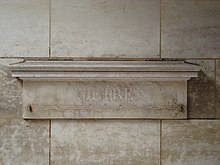| metre | |
|---|---|
 Historical public metre standard in Paris | |
| General information | |
| Unit system | SI |
| Unit of | length |
| Symbol | m[1] |
| Conversions | |
| 1 m[1] in ... | ... is equal to ... |
| SI units | |
| Imperial/US units | |
| Nautical units | ≈ 0.00053996 nmi |
The metre (or meter in US spelling; symbol: m) is the base unit of length in the International System of Units (SI). Since 2019, the metre has been defined as the length of the path travelled by light in vacuum during a time interval of 1/299792458 of a second, where the second is defined by a hyperfine transition frequency of caesium.[2]
The metre was originally defined in 1791 by the French National Assembly as one ten-millionth of the distance from the equator to the North Pole along a great circle, so the Earth's polar circumference is approximately 40000 km.
In 1799, the metre was redefined in terms of a prototype metre bar, the bar used was changed in 1889, and in 1960 the metre was redefined in terms of a certain number of wavelengths of a certain emission line of krypton-86. The current definition was adopted in 1983 and modified slightly in 2002 to clarify that the metre is a measure of proper length. From 1983 until 2019, the metre was formally defined as the length of the path travelled by light in vacuum in 1/299792458 of a second. After the 2019 revision of the SI, this definition was rephrased to include the definition of a second in terms of the caesium frequency ΔνCs. This series of amendments did not alter the size of the metre significantly – today Earth's polar circumference measures 40007.863 km, a change of about 200 parts per million from the original value of exactly 40000 km, which also includes improvements in the accuracy of measuring the circumference.
- ^ "Base unit definitions: Meter". National Institute of Standards and Technology. Retrieved 28 September 2010.
- ^ International Bureau of Weights and Measures (20 May 2019), The International System of Units (SI) (PDF) (9th ed.), ISBN 978-92-822-2272-0, archived from the original on 18 October 2021